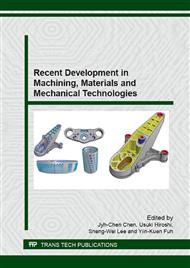p.164
p.168
p.174
p.180
p.185
p.191
p.198
p.204
p.208
Characterization of Machining Damages Generated by a Piercing Process in CFRP Laminates
Abstract:
This paper presents experimental examples of machining damages resulting from a piercing process in CFRP laminates. A circular perforation was formed in CFRP cross-ply specimen with a punch jig using different blade angles and two distinct dimensional conditions. Surface, cross-sectional, and internal changes to the CFRP specimens after the hole-punching were observed using optical microscopy and X-ray analysis to quantitatively evaluate damage, including delamination, around the perforation area. Results indicate that the optimum piercing is achieved when the blades are parallel to fiber direction at an elevated temperature with blade angles essentially irrelevant.
Info:
Periodical:
Pages:
185-190
Citation:
Online since:
July 2015
Authors:
Keywords:
Price:
Сopyright:
© 2015 Trans Tech Publications Ltd. All Rights Reserved
Share:
Citation:


